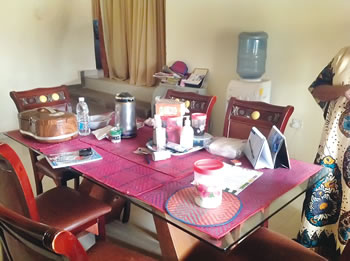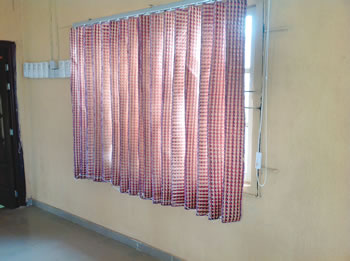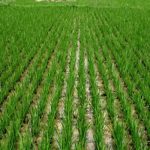Ogotun community in the Ekiti South West Local Government Area of Ekiti State is renowned for weaving mats. They take the craft as their life and are proud to relay their experiences of the past and present, when Sam Nwaoko visited the community.
Ogotun-Ekiti is one of the three major towns that make up the South West Local Government Area of Ekiti State. Being a boundary community between Ekiti and Osun States, it is bounded in the south by Ikeji Ile and in the east by Ikeji both in Osun. In the north, it is bounded by Igbara Odo, one of the three towns in the council area, which have their council headquarters in Ilawe-Ekiti.
To a lot of people, Ogotun is many things rolled into one. For some travellers, the idyllic or soporific community can pass for a veritable gateway. The community, to farmers, can stand its ground in agriculture and commerce as a result of the existing large farmlands. Ogotun-Ekiti also stands tall among communities with cultural ranking. Of a fact, the traditional ruler of the community, the Ologotun, is among the 16 first class monarchs in Ekiti State called The Pelúpelú while the reigning Ologotun, Oba Samuel Oladapo Oyebade, is the current Chairman of the Ekiti State Council of Traditional rulers.
In agriculture, Ogotun is also one of the communities with the largest farm settlements in Ekiti State, nay the South West. The agricultural lands of Ogotun are dotted with farmsteads that have sizable population of farmers. Members of the community claim that there are about 25 of such farmsteads, beginning with one named Olorioko community, which lies about 6 kilometres from Ogotun community centre.

However, Ogotun doesn’t seem to enjoy any reputation from its numerous farms as it does from a craft all have admitted it is supremely adroit at: Mat weaving. For the craft, Ogotun-Ekiti has earned a reputation that transcends age and geography. Natives of Ogotun, particularly the female folk, have sustained their ancient craft that has assumed a legendary status, both in and outside of the state, and have devised means of making a commercial success of the Ogotun mat.
For mat weaving, Ogotun has attracted the attention of government at the highest level, and the women told the Tribune, in their acknowledgement of this fact, that the government of General Ibrahim Babangida was the most rewarding for them and their craft. The people of the community also recalled with delight what they said the government of Chief Segun Oni did with regards to the development of the people and their craft, including an exchange trip to India by one of the prominent women in the craft.
This craft stands Ogotun out
The queen of Ogotun, Olori Comfort Omolade Oyebade, said the history of mat-weaving in Ogotun could be traced to the wife of Òjoruùbè, the progenitor of the town. She said the Ojorube’s wife she didn’t name, had brought the craft as she migrated with her husband from Ile Ife, to found the town. According to Olori Oyebade, the wife of Òjorùbè had brought with her African serepindity berry, ‘Ewé-Iran’ in local parlance or, more commonly in Yorubaland, ‘ewé moi moi’ (a non-wooden, natural plant replete in Nigeria, thaumatococus daniellii), with which she weaved mats.

Olori Oyebade said: “The founder of this community is known as Òjorùbè. He came from Ile Ife with his wife, who came with the ‘ewe iran’. She was weaving the mats for them to sleep on and for other uses and it became incumbent on the women to take to the craft, beginning from the early days.
“In those days, there were no beds and the mat was very handy and useful. The craft grew and more women got involved. It soon became a status symbol because how rich you are determines the kind of mat you sleep on.”
The Olori added that the women devised a means to further beautify their mats by dyeing them and even got more creative as modernity crept in. She noted that as time went, “if you could afford dyed mats, you acquire them. If you cannot, you make do with the normally-woven mats. The important thing is that you slept on a mat.”
According to her, “Ijesha people are called the “eleni ate’ka, eleni ewele…” (people with mobile or portable mats). Ogotun is the community that gives life to that appellation. We are the real “Eleni ate’ka, eleni ewele”. As a matter of fact, it is said that Ogotun speaks “Ìjèsà-Ekiti”. We still speak Ìjèsà-Ekiti. Our variant of the Yoruba language is closer to Ìjèsà than it is to Ekiti. In all, this craft stands Ogotun out.”
She said what she could recall as the most glorious era for the Ogotun mat business was the reign of the military President Ibrahim Badamasi Babangida. The Olori spoke glowingly of the efforts by the wife of the former president, Mrs Maryam Babangida. She recalled that the late Mrs. Babangida had used the opportunity of her defunct Better Life for Rural Women scheme to really make positive impact on the life of the mat-weaving women and their craft.
“Then she took many of the women to train them further in the craft and introduced more business angles to the mat trade. Then, the Better Life for Rural Women made us to realise that weaving of mats went beyond mat as something just to sleep on.

“Before the arrival of the Better Life scheme, the best our mats were used for, apart from sleeping, was to divide school or other classrooms. They also used them as ceiling for their roofs, before the asbestos became popular. But when Better Life scheme came, we realised that you could use mats for anything at all, anything you could think of.
“Bags, shoes, caps, hats, table mats, table covers, notepads, bible holders, car seat covers, window blinds, laptop bags, just anything you could conceive. When the governor of Osun State, Mr Rauf Aregbesola, visited us, he talked about his “Òpòn Ìmò” and some of the tablets were covered with Ogotun mats.
“The options are endless. One other remarkable thing about the Better Life for Rural Women Scheme then was that no matter the amount of mat you had weaved, the scheme would buy it up. It encouraged a lot of them to expand their businesses.”
The monarch’s wife also eulogised the efforts of a mat enthusiast and an exponent of Nigerian and African artifacts, Chief (Mrs) Aino Oni-Okpaku. She was honoured with the title of Yeye Afonasola of Ogotun Ekiti by Ologotun. “The Yeye Afonasola of Ogotun Ekiti is a Swede but married an Edo State man. She owns Quintessence in Lagos. Up till now she still buys our mats. When we call her that the women have mats and that there are poor sales, she will send a bus and buy all the mats. She still does that up till today.”
The Olori Ologotun said: “The Yeye Afonasola, the Swede took the Ogotun mat to 89 countries. When she attends any exhibition of crafts and she didn’t find the Ogotun mat, she’d say it’s not complete without Ogotun and refrain from taking active part. She is always there for the people: Trade fairs, exhibitions and so on. She will come around and take the women on her own and sponsor them and promote them.”

She also noted that successive governments in Ekiti State had done their bit in promoting the craft. However, she pointed out that the administration of Chief Oni did what she said was “the most in this regard.”
She said: “I will readily recall that the administration of Segun Oni did a lot for the industry. In fact, his administration did so much for the improvement kf the craft and also sent one of our women to India for an exchange programme. She went there to learn their own way of making their mats and she found that they use pineapple leaves mostly. But she didn’t have western education, so her development was limited and there wasn’t so much she could do in terms of adding value to her’s and others’ skills. I would add that there’s no government that didn’t do one thing or the other but the most was done by the Segun Oni government in the state. Then I also remember the enormous efforts made by Mrs Feyi George, wife of a former military governor of old Ondo State.”
Women in the craft
Mrs. Rechael Olarinre Ogundiran, of about 76 years of age, is popularly known by the people of the community as “Èye India.” This is because she had travelled to India during the regime of Chief Segun Oni to further expand her frontiers in the craft, for which has dexterity is said to be legendary. Madam Ogundiran chuckled when asked how long she’s been weaving mats, but volunteered that “I started as a child, having learnt from my mother, who was also doing it.”
She reiterated the notion that the craft was a common thing among the people of Ogotun and was of the opinion that it was a craft that they don’t see as something special. “Even school children do it, sometimes as home work and, maybe examination.” She held that by so doing, the craft is preserved and its development remained among the people.
Èye India also recalled the “Better Life” days with some relish, and said “then we travelled round and weaved more frequently because of high volume of demand.”
Mrs Veronica Kayode’s cognomen is Èye Dudu. Her skill in the craft is also of high reputation. She was smart and businesslike in her approach to the mat-weaving discussion as she walked this reporter to her home. She showed a mat in the works, a plain mat that has been woven halfway by one of her neighbours. “When her child returns from school, she would add to the weaving and might finish it today,” she volunteered.
Eye Dudu said the craft helped her through the difficult times that followed the death of her husband “many many years ago.” She said her skill helped her to earn money with which she paid for the education of her children in the absence of her husband. “I’ve been in the mat business since we sold mats for 4kobo. I started as a child too and it really helped me then because my children were very young.” Now that the mats sell for as much as between N4,000 and N4,500, the business has really come of age.
Kayode said the dyes she named as jélú (purple); mokore (green); ródosùn (red) and òrìn she said was ‘Ajoo’ in those days (beige) are bought from Ibadan.
For Eye Dudu, apart from the Better Life, the Oyibo woman has been another source of joy to her in her life of mat-weaving and business. When asked of her experience with the mat enthusiast, the Swedish-Nigerian and Yeye Afonosola of Ogotun-Ekiti, Chief (Mrs) Oni-Okpaku, Mrs. Kayode was all smiles.
“Ah! The woman is very good to us. Whenever she comes, we are sure she will buy. Sometimes, she buys up to 2,000 mats from the community.”
What future for Eni-Iran?
For Eye India, Eye Dudu and a young mat enthusiast, Miss Mofebisola Oyebade, one of the youngsters in the business of mat-weaving and marketing, the future is in the hands of the people. For now, weaving with bare hands is the only way since there are no machines yet to do that. Weaving a mat, which could be described as building an intricate network of numerous straws, requires determination, patience and perseverance.
For those who have travelled the eni-iran road for decades and for the younger generation, there’s always the mythical Eye Eledegbe the community sings about in relation to the Ogotun mat. The legend, according to the Olori Ologotun, is that Eye Eledegbe is a mother that ensures the
Olori Oyebade explained that mythically, the people refer to the mat as Eye Eledegbe and sing its praises. “The people believe that it is a mother and that when you see Èye Elédègbe, your problem is solved in many ways. ‘Mo r’Eledegbe o, mo yó d’oke aya. O da olugba o sa ale; o da elegbewa di àsòmorò…” they’d sing of the mat,” she stated.
It is our belief that once you’re faithful to the business of mat-weaving, you’d at least solve you little little economic problems.
However, a study on mat weaving in Ogotun, carried out by some Ekiti State University (EKSU) students in May 2012, found that “the style of mat weaving of these rural dwellers no longer meet the modern global standard, as such they are faced with very low patronage and acceptability.”
How we are exporting our mat heritage outside Nigeria, says Mofebisola of Estera Concepts
Mofebisola Oyebade, a princess of the Ologotun has taken up the responsibility of being a promoter of the Ogotun craft. Currently studying for her Master’s degree while also running an outfit called Estera Concepts, she told Sam Nwaoko her vision for the mat heritage and efforts at sustaining it.
What’s the vision behind Estera Concepts?
I started Estera Concepts in 2015 November when I’ve just finished with my National Youth Service (NYSC) and was home in Ekiti. Members of the family had a discussion while at home one evening on eni-iran (the mat from ewe iran) and I decided to take it up. I realised that mat weaving is no longer as viable as it was while I was growing up, when lots of people could weave , including youths and not just old women.
The people who weave now are in their 50s and 60s and older. The youth don’t have interest in it. So, I decided within me to keep the heritage of my people, that gave rise to the starting of Estera Concepts.
So, what do you do at Estera, and how profitable has the business been?
For us at Estera Concepts, it’s not about the profit but showcasing to the world the heritage of Ogotun-Ekiti and ensuring that mat weaving does not go into extinction. To achieve this, we have created a medium through which the mat would be used for other things beyond its traditional use. This will in the long run increase the demand for mats, which would lead to more production.
At Estera, all we do is eni-iran; we create items that are useful in our everyday life. We combine mat with other materials, mainly leather.
Do you know how to weave mats yourself?
Yes I can weave. But I hardly weave because of lack of time and other things I’m currently into. However, to achieve our vision of the sustenance of our Ogotun mat-weaving heritage, we have brought in young people and they are beginning to show interest. That’s where we will be focussing our corporate social responsibility (CSR).”
How about marketing your products?
From our products, it is obvious that mats are not the only thing we use in creating them. To market them, what we’ve done is mainly through the word of mouth and referrals. We also use the social media, Twitter, Facebook and Instagram. Secondly, my family is very helpful. I probably would have given up without their support.









